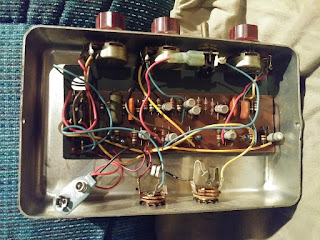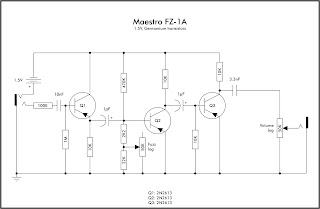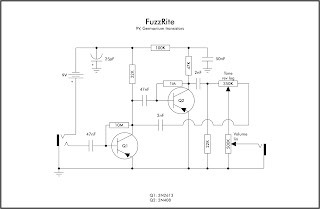When I was looking for information about the fOXX Tone Machine; this red label version caught my attention. Most foxx fuzzes I've seen have a flocked fuzzy finish, a blue label, a carling toggle switch with on/off plate, and three cosmo knobs. Like this:
But this one has no fuzzy exterior (it looks more like the crinkle finish on Shin Ei pedals), a red label, a switch with no on/off plate, and different knobs. Also note the 9V jack and the recessed foot switch, similar to the Shin Ei SF-1 super fuzz .
I used to have an amp with the same style knobs. The "Global 4080". (aka Harmony 4080)
The red label Tone machine also has a redesigned circuit board.
(There is at least one with the old pcb though)
and that looks a lot like the Global amp and my 1976 Shin Ei SF-1 Superfuzz:
Blue label:
The global amp also uses CTS pots and the PCB says made in Korea.
The transistors (and some of the other parts) look very similar to the ones in the red label Tone Machine.
The second picture is from this listing:
The potentiometers in that unit were made by CTS in late august 1976.
Which is interesting since according to interviews with Steve Ridinger and Dick Norse (from Art Thompsons book "Stompbox"*) fOXX went out of business in mid 1975, and all their assets "were auctioned to someone in Chicago". So maybe?
or Sears?
I looked through all the sears catalogs I could find and the Tone Machine isn't in any of them.
Other foxx pedals appear from Fall/Winter '74 through to Fall/Winter '76.
So did this this "someone in Chicago" continue to build foxx pedals with the leftover parts and then have new circuit boards and enclosures made in Asia?
If you know anything I missed here, please let me know.
UPDATE!!
Looks like the mysterious buyer might've been Fred Gretsch Enterprises!
As you can see here Fred Gretsch Enterprises announce to dealers that "We are now exclusive distributors for all FOXX and BALL products and are manufacturing these products here in Chicago."
These pictures come from this old reverb listing:
Ok, so I wasn't completely wrong:
"In 1971, he started Fred Gretsch Enterprises, a Chicago-area business that imported and exported a wide range of musical instruments for large national retailers such as Sears, Montgomery Ward, Spiegel, and Aldens. He also purchased equipment from the defunct Harmony Company in the mid-70s and manufactured banjos under the Chicago brand name."
Here's another interview with Fred Gretsch where he talks about his work in the 70's:
Here's what the "new" circuit boards look like:
And the schematic:
The cap between the base and collector on Q1, and the resistor coming from the 9V are new.
All of the other differences in the newer schematic were there on the original PCB's, but never soldered in.
Also these new boards use ECB transistors whereas the old ones used EBC transistors.
Also check out the Effects Database pages on fOXX:
*https://www.thriftbooks.com/w/the-stompbox-a-history-of-guitar-fuzzes-flangers-phasers-echoes-and-wahs_art-thompson/1521291/#isbn=0879304790
As a bonus here are the four different styles of labels I've found so far:























































